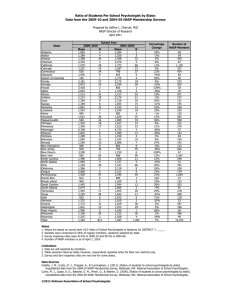Document 10473219
advertisement
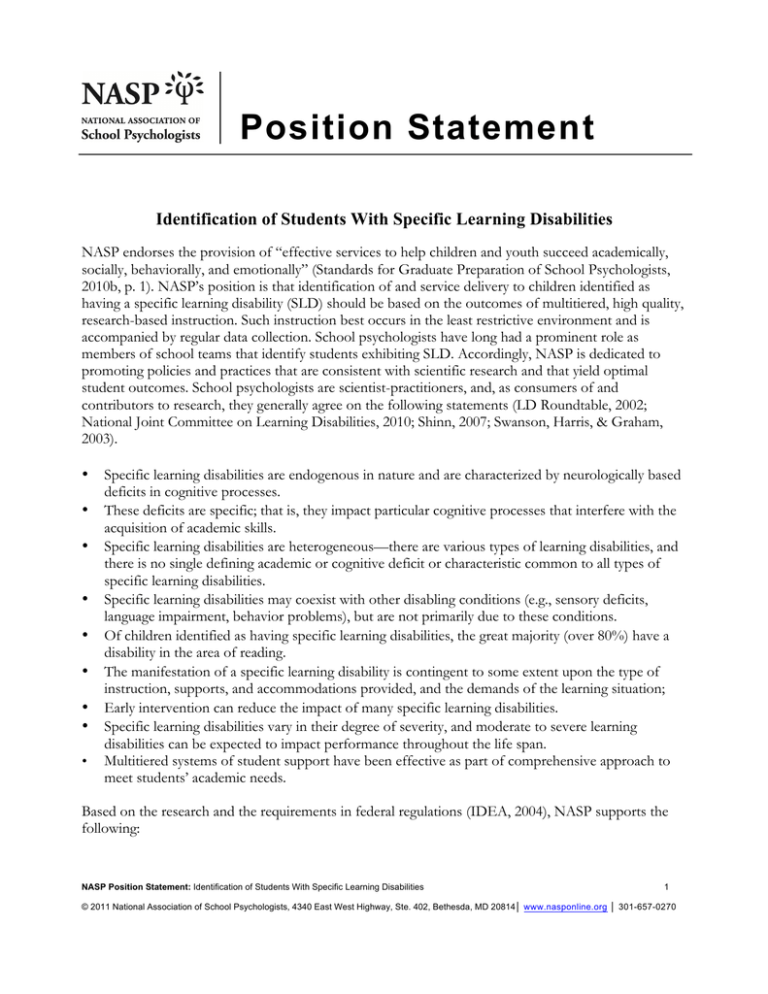
Position Statement Identification of Students With Specific Learning Disabilities NASP endorses the provision of “effective services to help children and youth succeed academically, socially, behaviorally, and emotionally” (Standards for Graduate Preparation of School Psychologists, 2010b, p. 1). NASP’s position is that identification of and service delivery to children identified as having a specific learning disability (SLD) should be based on the outcomes of multitiered, high quality, research-based instruction. Such instruction best occurs in the least restrictive environment and is accompanied by regular data collection. School psychologists have long had a prominent role as members of school teams that identify students exhibiting SLD. Accordingly, NASP is dedicated to promoting policies and practices that are consistent with scientific research and that yield optimal student outcomes. School psychologists are scientist-practitioners, and, as consumers of and contributors to research, they generally agree on the following statements (LD Roundtable, 2002; National Joint Committee on Learning Disabilities, 2010; Shinn, 2007; Swanson, Harris, & Graham, 2003). • • • • • • • • • Specific learning disabilities are endogenous in nature and are characterized by neurologically based deficits in cognitive processes. These deficits are specific; that is, they impact particular cognitive processes that interfere with the acquisition of academic skills. Specific learning disabilities are heterogeneous—there are various types of learning disabilities, and there is no single defining academic or cognitive deficit or characteristic common to all types of specific learning disabilities. Specific learning disabilities may coexist with other disabling conditions (e.g., sensory deficits, language impairment, behavior problems), but are not primarily due to these conditions. Of children identified as having specific learning disabilities, the great majority (over 80%) have a disability in the area of reading. The manifestation of a specific learning disability is contingent to some extent upon the type of instruction, supports, and accommodations provided, and the demands of the learning situation; Early intervention can reduce the impact of many specific learning disabilities. Specific learning disabilities vary in their degree of severity, and moderate to severe learning disabilities can be expected to impact performance throughout the life span. Multitiered systems of student support have been effective as part of comprehensive approach to meet students’ academic needs. Based on the research and the requirements in federal regulations (IDEA, 2004), NASP supports the following: NASP Position Statement: Identification of Students With Specific Learning Disabilities 1 © 2011 National Association of School Psychologists, 4340 East West Highway, Ste. 402, Bethesda, MD 20814│ www.nasponline.org │ 301-657-0270 • • • • • • Identification of and instruction for children suspected of having SLD should be implemented within the context of an evidence-based multitiered service delivery system. Such systems provide high quality and timely educational strategies, and a continuum of data-based academic/behavioral instruction within general education for children with learning problems (National Association of School Psychologists, 2010a). A multitiered model in which instructional strategies are more focused or intensively delivered, providing quality instruction in the general education classroom in addition to timely interventions before a special education referral is considered. Universal screening of academic and behavior skills should be conducted during all elementary school years and selectively, as needed, in the middle and high school years. When a specific learning disability is suspected, and appropriate instruction and intervention within general education fail to meet a child’s educational needs, a comprehensive evaluation by qualified professionals is an essential step in determining SLD eligibility and individualized educational needs (Elliott, 2008). It is best practice to look at multiple sources of data, including how students respond to scientifically based instruction, including environmental and instructional conditions. Relying upon an ability–achievement discrepancy as the sole means of identifying children with specific learning disabilities is at odds with scientific research and with best practice (Gresham & Vellutino, 2010). It is critical for school psychologists to continually upgrade their knowledge and skills and use only those methods which have research support (National Association of School Psychologists, 2010c). SLD IDENTIFICATION WITHIN A MULTITIERED MODEL A multitiered model (also known as response to intervention or RTI) is intended to provide for quality instruction in the general education classroom and timely interventions in general education before a special education referral is considered (National Association of School Psychologists, 2010b). Multitier systems are delivered on a continuum based on the student’s learning needs. Multitier systems begin with high quality instructional and behavioral supports for all students in general education. Based on student learning outcomes, strategic and intensive interventions may be used to improve student performance (National Association of School Psychologists, 2009a, 2009b). A child’s lack of responsiveness to appropriate learning experiences in general education can also contribute to SLD identification. For example, data from targeted and/or intensive interventions for students whose performance and rate of progress are below what is expected for their grade and educational setting should be incorporated in SLD evaluation procedures. COMPREHENSIVE EVALUATION OF CHILDREN WITH SUSPECTED SLD The primary purposes of a comprehensive evaluation are to determine if the child has a SLD, and to make recommendations regarding educational placement and instructional interventions. In accordance with federal law, the individualized education plan (IEP) team and other qualified professionals must review existing data during an initial evaluation and during any reevaluations. This includes prior evaluations, current classroom-based assessments, local or state assessments, classroom observations, and input from parents to identify what additional data, if any, are needed to determine whether the child has a SLD. The evaluation includes a variety of assessments and other evaluation methods that must not be discriminatory on a racial or cultural basis, must be administered in the language and form most likely to yield accurate information, are used for purposes for which the measures are reliable and NASP Position Statement: Identification of Students With Specific Learning Disabilities 2 © 2011 National Association of School Psychologists, 4340 East West Highway, Ste. 402, Bethesda, MD 20814│ www.nasponline.org │ 301-657-0270 valid, are administered by trained and knowledgeable personnel and in accordance with instructions provided by the producer, and encompass all areas of suspected disability. The goal of evaluation is to gather relevant functional, developmental, and academic information, including information provided by the parent, to determine whether the child has a specific learning disability and to ascertain the educational needs of the child. In making a determination of eligibility, the evaluation team also considers whether the determining factor is the lack of appropriate instruction in reading or math, limited English proficiency, or cultural and linguistic differences. Evaluation teams should consider whether the multitiered interventions and assessment techniques utilized are culturally sensitive and adequately address the issues related to English language learners. NASP recommends that initial evaluation of a student with a suspected specific learning disability include individual comprehensive assessment, as prescribed by the evaluation team. Existing data from a problem-solving process that determines if the child responds to scientific evidence-based intervention may be considered at the time of referral, or new data of this type may be collected as part of the comprehensive evaluation. Identification and eligibility determinations should not be based on any single method or measure. A comprehensive evaluation may include historical trends of performance and current measures of academic skills (norm-referenced, criterion-referenced, and/or curriculum-based), cognitive abilities and processes, and social–emotional competencies and oral language proficiency as appropriate; classroom observations; and indirect sources of data (e.g., teacher and parent reports). Paramount to use of any assessment is the relevance of the data to subsequent intervention. THE ROLE OF SCHOOL PSYCHOLOGISTS The expertise and support of school psychologists can be a critical factor in the effective implementation of a multitiered model (Machek & Nelson, 2010). On a school-wide basis, school psychologists consult with teachers concerning evidence-based instruction, interventions, periodic screening of pre-academic and academic skills as well as social–emotional competencies, and serve as problem solving team leaders. When students struggle with the general education curriculum, school psychologists collaborate with general and special education teachers and support services personnel to design and implement effective, evidence-based strategies, and to evaluate the effectiveness of interventions with regular progress monitoring. When students require more intensive individualized support, school psychologists work with other school personnel to consider programmatic options, and consider the composition of a comprehensive evaluation. School psychologists should play a key role in both direct and indirect service delivery, based on student need, to maximize educational outcomes for all children. Using data from universal screening and student response to instructional intervention, school psychologists also have a major role in planning and conducting comprehensive evaluations to determine eligibility for special education services and the educational needs of the child. In the course of designing or conducting assessments, both in general and special education, school psychologists should strategically select assessment procedures with clearly defined purposes in mind. NASP Position Statement: Identification of Students With Specific Learning Disabilities 3 © 2011 National Association of School Psychologists, 4340 East West Highway, Ste. 402, Bethesda, MD 20814│ www.nasponline.org │ 301-657-0270 Expertise in SLD is an essential area of specialization for all school psychologists. Therefore, school psychologists should be knowledgeable about the following: • • • • Federal and state laws and regulations, and (where applicable) state and local guidelines regarding special education evaluation procedures; Assessment measures and procedures that adhere to professional standards and enable school psychologists to address the requirements listed above, including curriculum-based and normreferenced measures of academic skills, procedures for screening academic progress and monitoring response to intervention, norm-referenced measures of basic psychological processes, and measures of social–emotional competencies and behaviors; Emerging research on specific learning disabilities, including the nature of learning disabilities, and effective interventions; Effective instructional practices including research-based practices for general education, the relationship between results of comprehensive assessments and the recommendations that can be made for strengthening classroom instruction, research-based instructional practices for culturally and linguistically diverse students, and the impact of cultural and linguistic diversity on response to instructional intervention. Note. Other NASP position statements that are relevant to this statement on the identification of students with learning disabilities can be found on the NASP website at www.nasponline.org. REFERENCES Elliott, C. D. (2008). Identifying a learning disability: Not just product, but process. In E. FletcherJanzen & C. R. Reynolds (Eds.), Neuropsychological perspectives on learning disabilities in the era of RTI: Recommendations for diagnosis and intervention. (pp. 210–218). Hoboken, NJ: John Wiley & Sons, Inc. Gresham, F. M., & Vellutino, F. R. (2010). What Is the Role of Intelligence in the Identification of Specific Learning Disabilities? Issues and Clarifications. Learning Disabilities Research & Practice (Blackwell Publishing Limited), 25(4), 194–206. LD Roundtable. (2002). Specific Learning Disabilities: Finding common ground. Washington DC: Office of Special Education Programs. Retrieved from http://www.nasponline.org/advocacy/SLD_OSEP.pdf. Individuals with Disabilities Education Act. (2004). Public Law 108-446. Machek, G. R., & Nelson, J. M. (2010). School Psychologists’ Perceptions Regarding the Practice of Identifying Reading Disabilities: Cognitive Assessment and Response to Intervention Considerations. Psychology in the Schools, 47(3), 230–245. National Association of School Psychologists. (2009a). Appropriate academic supports to meet the needs of all students [Position statement]. Retrieved from: http://www.nasponline.org/about_nasp/positionpapers/AppropriateAcademicSupport.pdf National Association of School Psychologists. (2009b). Appropriate behavioral, social, and emotional supports to meet the needs of all students [Position statement]. Retrieved from: http://www.nasponline.org/about_nasp/positionpapers/AppropriateBehavioralSupports.pdf National Association of School Psychologists. (2010a). Model for comprehensive and integrated school psychological services. Bethesda, MD: Author. National Association of School Psychologists. (2010b). Standards for graduate preparation of school psychologists. Bethesda, MD: Author. NASP Position Statement: Identification of Students With Specific Learning Disabilities 4 © 2011 National Association of School Psychologists, 4340 East West Highway, Ste. 402, Bethesda, MD 20814│ www.nasponline.org │ 301-657-0270 National Association of School Psychologists. (2010c). Recommendations for the reauthorization of the Elementary and Secondary Education Act (ESEA). Retrieved from: http://www.nasponline.org/advocacy/nclb/naspcomments.pdf National Joint Committee on Learning Disabilities. (2010, June). Comprehensive Assessment and Evaluation of Students With Learning Disabilities. Retrieved from http://www.ldanatl.org/pdf/NJCLD%20Comp%20Assess%20Paper%206-10.pdf Shinn, M. R. (2007). Identifying students at risk, monitoring performance, and determining eligibility within response to intervention: Research on educational need and benefit from academic intervention. School Psychology Review, 36(4), 601–617. Swanson, H. L., Harris, K. & Graham, S. (2003). Handbook of learning disabilities. New York, NY: Guilford Press. Adopted by the NASP Delegate Assembly on July 16, 2011. Please cite this document as: National Association of School Psychologists. (2011). Identification of Students With Specific Learning Disabilities (Position Statement). Bethesda, MD: Author. NASP Position Statement: Identification of Students With Specific Learning Disabilities 5 © 2011 National Association of School Psychologists, 4340 East West Highway, Ste. 402, Bethesda, MD 20814│ www.nasponline.org │ 301-657-0270
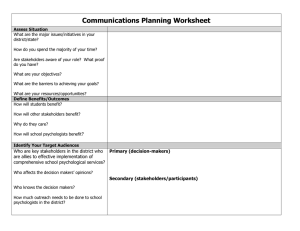
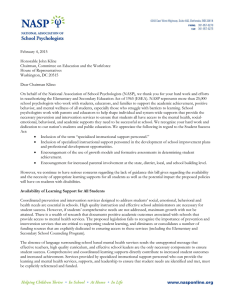
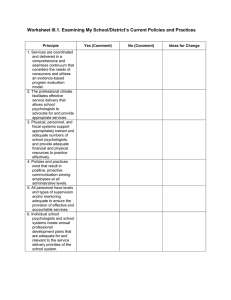
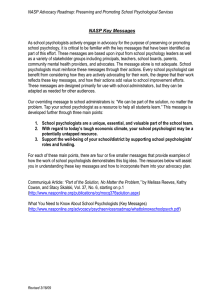
![[Today’s Date] [Your Supervisor’s First Name] [Your School or District’s Name]](http://s2.studylib.net/store/data/010451343_1-ed5410b4013e6d3fbc1a9bbd91a926a9-300x300.png)
